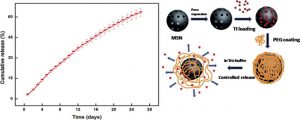Researchers solve the puzzle of controlled therapeutic release of macromolecules
 When a large volume of medication is the prescription, steady and controlled release of the drug sometimes is preferred by physicians over a “burst-release” treatment in which the substance is administered all at once. In recent years, researchers have developed numerous ways to administer substances in a controlled way, but doing so for therapeutics of large molecular size has been an elusive goal, especially when one needs nanoparticles for the delivery.
When a large volume of medication is the prescription, steady and controlled release of the drug sometimes is preferred by physicians over a “burst-release” treatment in which the substance is administered all at once. In recent years, researchers have developed numerous ways to administer substances in a controlled way, but doing so for therapeutics of large molecular size has been an elusive goal, especially when one needs nanoparticles for the delivery.
Researchers in the Department of Bioengineering have developed a methodology that enables the constant release of macromolecules over long periods of time — in fact, up to four weeks — potentially eliminating the problems often associated with bolus (or all-at-once) treatments.
The research team, led by Sanjib Bhattacharyya, a research associate in the lab of Bioengineering Professor Paul Ducheyne, combined mesoporous silica nanosphere (MSN) cores with a grafted biocompatible polyethylene glycol (PEG) polymer surface. The pore size of the MSNs was then expanded, and a large model molecule, trypsin inhibitor (TI) with a molecular weight of 23,000 Da, was inserted. The researchers then tracked the release of TI macromolecules from the nanospheres during a four-week period.
“The release approached a constant rate over the full duration of the experiment for pore-expanded MSNs, but not for the untreated MSNs,” wrote the researchers whose work was published in the September issue of Acta Biomaterialia. “Among other benefits, it is apparent that the PEG coating successfully eliminated the initial burst exhibited by control samples without PEG film.”
Bhattacharyya noted that the pore expansion and the amount of polymer used to coat the surface were critical factors in the experiment’s success.
The research potentially points the way for improved administration of important therapeutics such as growth factors. “It’s very hard to release molecules over such a long period of time,” he said. “One of the big advantages to this system is that the substances can be released continuously for several weeks.”
Said Ducheyne, “We are thinking about this not just for macromolecules. “Other ongoing work entails dual treatments, such as growth factor delivered in a scaffold and administered along with antibiotics to treat concomitant infections.”
